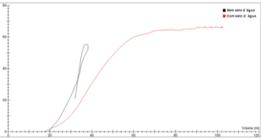PURPOSE:
To investigate the hemodynamic and ventilatory changes associated with the creation of an experimental bronchopleural fistula (BPF) treated by mechanical ventilation and thoracic drainage with or without a water seal.
METHODS :
Six large white pigs weighing 25 kg each which, after general anesthesia, underwent endotracheal intubation (6mm), and mechanically ventilation. Through a left thoracotomy, a resection of the lingula was performed in order to create a BPF with an output exceeding 50% of the inspired volume. The chest cavity was closed and drained into the water sealed system for initial observation of the high output BPF.
RESULTS:
Significant reduction in BPF output and PaCO2 was related after insertion of a water-sealed thoracic drain, p< 0.05.
CONCLUSION:
Insertion of a water-sealed thoracic drain resulted in reduction in bronchopleural fistula output and better CO2 clearance without any drop in cardiac output or significant changes in mean arterial pressure.
Respiratory Tract Fistula; Respiration, Artificial; Models, Animal; Swine

 Thumbnail
Thumbnail
 Thumbnail
Thumbnail

